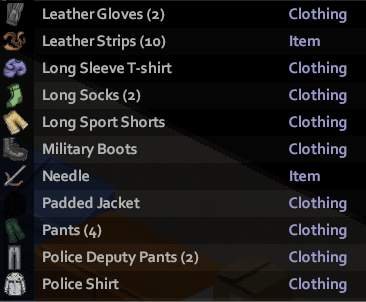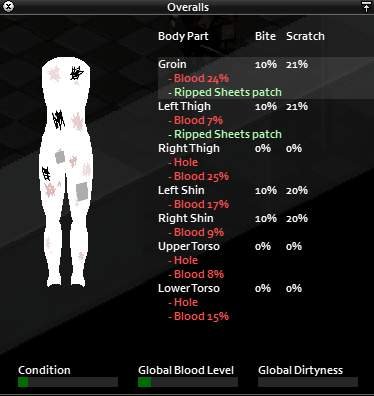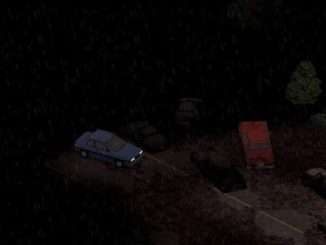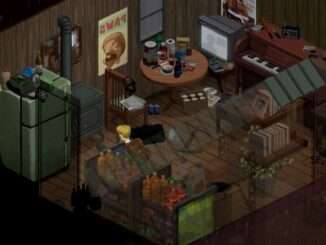
Tailoring is one of the newest, and thus least documented skills in the game at time of writing.
Guide to Tailoring
Why Tailoring?

First and foremost, why bother with tailoring at all?
Inevitably, clothing in Project Zomboid will start to deteriorate. Holes will form, usually from combat, ruining your protection for certain body parts, and making you that much weaker if you’re unlucky enough to get scratched. Plus, holes in clothing provide no insulation, and if you’ve survived long enough to see the snow fall, this can spell disaster.
Granted, you can always grab more clothing off the undead, or from scavenging, but in addition to putting yourself in harm’s way, you might eventually become hard-pressed to find good quality replacements for certain rare articles of clothing. Plus, clothing on zombies is often worn, or becomes worn during combat, meaning you might be out of luck even if you spot a zombie wearing something valuable.
Finally, and perhaps most importantly, leveling tailoring allows you to increase the defensive ability of your existing clothing, via the addition of patches, even when no hole is present. Higher levels increase the bonus given by applying a patch, one of the main incentives of learning tailoring. Don’t wanna get screwed by RNG? Better armoring your clothing helps!
What You’ll Need
Before you can begin tailoring, there are a number of items you’ll need.
Clothes
Well…obviously.
Needle
The primary tool of the aspiring tailor. Used for a few things, but in the context of this guide it’s required for sewing clothing in any which way. Needles are indestructible, so as soon as you find one you’re set for life.
Thread
Tailoring-specific consumed item also required for sewing, and maybe even a bit of crafting. Found inside houses and stores occasionally. Thread runs out quick during sewing, but thankfully it can be found rarely by ripping up clothes.
Scissors
Most clothes are just made of fabric, but some are made of denim or leather. These materials are much more coveted, but cannot be torn by hand. Find a pair of scissors instead.
Fabric
You may already have a lot of these in the form of ripped sheets, which as you can guess are good for more than makeshift bandages. By using scissors on the tougher clothing you can acquire denim and leather strips as well. These are used for patches, and if they’re bloody, must be cleaned before use.
Literature
Tailoring is a grind, and you’ll need the xp modifier from skill books to get anywhere. Tailoring books are notoriously hard to find in my and many others experience for some reason. Found rarely in book stores, and more commonly in clothing stores. Grab these even if you don’t think you’ll need them because of the rarity alone.
As long as you know where to look, most of these items can be found without incident. Needles don’t require much of a concentrated effort to find, whereas scissors can be found in lockers or school desks fairly commonly.
Thread is not easy to come by unless you collect large amounts of unneeded clothing and rip it up. If you’re at the point where you can worry about leveling tailoring, you’ll probably have a large pile of zeds in or around your base. Ripping up all their clothing before they decompose can yield a nice large supply of thread. Additional tailoring levels increases the chance of getting thread from ripping clothes.
Side note: Needles and thread can be used to stitch deep wounds in a pinch. If you find yourself out of suture needles, make sure not to go through your entire supply of thread before finding more, or you might find yourself in real trouble. Yes, this happened to me.
The Tailoring Grind

So you have everything you need, and maybe even read the skill books too. Now comes the boring part.
In order to actually repair and maintain your clothing, you will need to right-click each article of clothing in your inventory, and click ‘Inspect’ This will open a new window which shows a detailed view of your clothing. Different types of clothing cover different body parts; here you can see exactly which parts are covered, what the defensiveness of each part is, and if there are any holes or blood. Right-clicking on any body part will allow you to add or remove patches from it, assuming you have a needle, thread, and fabric in your inventory.
Experience is gained by adding or removing patches to a specific part of your clothing. Thread is consumed in the process of adding, and patches have an increasingly higher chance of being recovered when removed as you level your skill.
Whenever you have the chance or feel like it, grab a piece of clothing you don’t particularly care about, your equipment, and a large supply of fabric (I recommend ripped sheets due to the abundance), and start adding and removing. Speed up time as you desire, and you’ll slowly start to gain experience.
Note: Not all clothing is equal! Some you just cannot repair or add patches to at all. This is no comprehensive list, but shoes, helmets, firefighter gear, police and military-style vests cannot be repaired at all. Once they’re gone, they’re gone!
Reap What You Sew

As previously mentioned, clothing can be both repaired and armored through tailoring. Let’s take a closer look at that.
Besides just patching holes in your gear, adding extra layers of fabric to your clothes increases your chances of not getting your game ruined by a single zombie. Each part of clothing has a set bite and scratch defense percentage, which can be increased with the addition of strips of cloth. From worst to best you have ripped sheets, denim strips, and leather strips, each having its bonuses increased every 2 levels of tailoring. Taken from the wiki:
Ripped sheets provide no additional bite defense, only scratch defense, and a pitiful 1% to start with at lowest level. At level 10 tailoring, applying ripped sheets adds an extra 5% scratch defense to each body part.
Denim strips provide a small bonus to bite defense, and slightly better scratch defense, and are not too hard to find given the abundance of jeans. At level 10 tailoring, denim strips provide 5% bite defense and 10% scratch defense.
Leather strips are the hardest to come across, and should be used sparingly, but provide great bite and scratch defense. At level 10 tailoring, leather strips provide 10% bite defense, and 20% scratch defense.
Plus the aforementioned benefit to increasing chance to find thread. Also, taken from the wiki (but not tested in my own play), level 8 tailoring allows you to completely repair a hole in clothing, letting you add padding afterwards instead of just patching it up. Material restrictions apply, and any clothing that cannot be patched up normally cannot be restored either.





Yes I live much longer with tailoring maxed!
Level 8 tailoring truely lets you fill the holes in your clothing, … I just tested it in my own game ( Ihave level 8)… Only the condition on these clothes are not restored… Thannx for this tipp, I didn`t know that
the hole repairing at level 8 must be a new update, I had a character back in April and they required level 10 tailoring to repair a hole.
scratch/bite protection benefits are awesome for SP… but not worth the grind, for MP you’ll not be investing in it since there are no PVP benefits. Unless you find a mods that adds a lot to tailoring AND makes it a lot less grindy there’s no need to care about the skill.
thanks for your input but I won’t be doing any PVP at all so just say thanks to the creator
Right now they implemented some benefits for pvp with bullet resistance. So tailoring may be worth it, however I don’t see how you’d grind a skill you can lose from a single shotgun blast to the face. I’d have to say that leather patches can be changed to black via mod, because they’re an ugly tan color in vanilla.
Blunt weapons do not damage clothing, so you can either carry a blunt weapon or shove/stomp a zombie to death. Some of their clothing especially in the beginning is in perfect condition so long as you don’t take a machete to it.
The higher your tailoring level the more likley u are to salvage thread from clothing